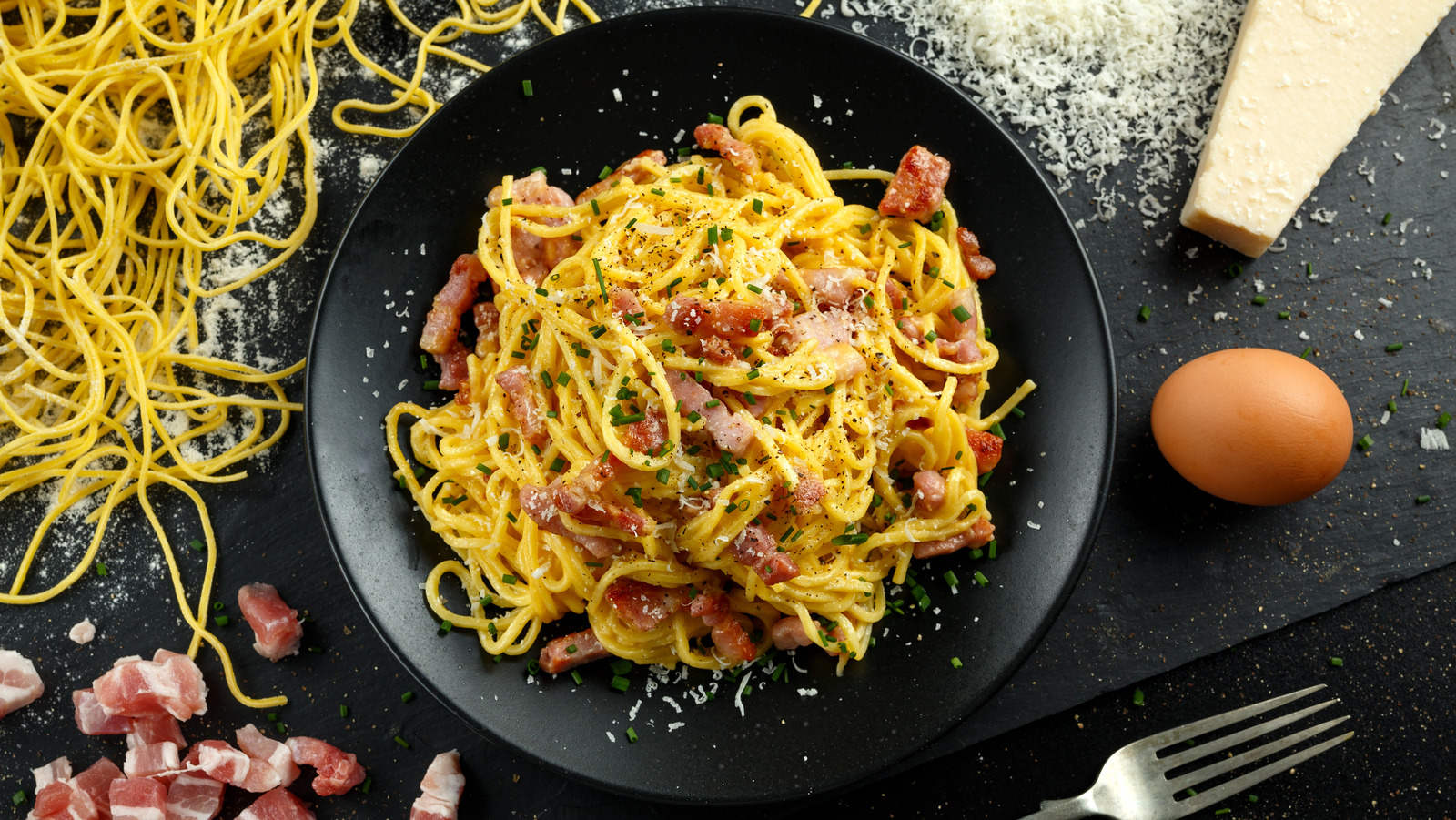
The 4 Types Of Classic Roman Pasta, Explained – Tasting Table
From beautifully prepared whole artichokes to stewed oxtail and even whipped cream stuffed buns, Rome is known for all sorts of culinary delights. That said, it’s the eternal city’s beloved pasta dishes — cacio e pepe, gricia, carbonara, and amatriciana — that remain the most celebrated of Roman classics. Though all are pasta preparations, each is distinct, and we’re here to help demystify each of these four classic dishes once and for all.
Based on a long-standing history of cucina povera (or peasant-style cookery), many Roman recipes use a handful of local ingredients with great finesse to craft such hearty and delicious meals. Classic Roman pastas speak very much to this heritage, each offering up a stick-to-your-ribs result that can be concocted with a total of five ingredients or less.
These four types of pasta, simple as they are, even share ingredients and riff on one another quite heavily. For instance, all four are graced by the region’s Pecorino Romano cheese, which adds a complementary spicy tang to every pasta pillar. Likewise, all of the silky sauces are also a product of emulsification between fat and pasta water. However, the exact recipes and the lore surrounding each of the Roman pasta dishes remain relatively distinct.
Cacio e Pepe
 Olga Larionova/Shutterstock
Olga Larionova/Shutterstock
Considered the Roman dish that sparked all the others, cacio e pepe — a rough translation of “cheese and pepper” — is often traced back to shepherds that would carry pecorino, pepper, and pasta with them as they moved their flocks. Not only did the ingredients travel well, but they would keep shepherds nourished and even warm, as black pepper stimulates circulation. Moving from the sustenance of mountain dwellers to a trattoria staple, cacio e pepe captured the hearts of many due to its great simplicity and equally great flavors.
Yet, while the recipe boasts the fewest ingredients, it also requires the highest level of skill to pull off. For example, to achieve the punchiest flavor, it’s recommended to toast freshly cracked black pepper to unlock its full potential. As for how to craft the creamiest sauce, refrain from adding any extras like butter or cream and focus on technique. The trick is to furiously stir modest amounts of pasta water with heaps of finely grated pecorino romano for seamless emulsification and, consequently, a luscious sauce.
When it comes to choosing a pasta variety, the Romans tend to serve cacio e pepe with thick strands of fresh tonnarelli. However, the decadently piquant sauce can also work well with varieties like spaghetti or pici. In contrast, shorter pastas like rigatoni or mezze maniche that have ridges to trap sauce can also be a great match for cacio e pepe.
Gricia
 Alessio Orru/Shutterstock
Alessio Orru/Shutterstock
Pasta alla gricia is essentially an elevated cacio e pepe, thanks to the addition of guanciale. The thin strips of fried cured pork cheek work to heighten umami, along with giving the dish a meatier edge. Plus, the rendered fat from the guanciale helps when it’s time to emulsify the sauce, amping up the richness and complexity.
Gricia, like cacio e pepe, has pastoral origins. It was also thought to have been developed by shepherds in the areas near Rome, specifically Grisciano, which is why you may sometimes see the sauce written as griscia. However, aside from a change in spelling, the recipe of pecorino, pepper, guanciale, and pasta water remains unchanged. But that isn’t to say that there aren’t other renditions of pasta alla gricia that take creative liberties. For instance, some omit pepper in an effort to be as historically accurate to the original as possible since black pepper was likely too expensive to be used regularly until postwar times. Alternatively, you could keep the pepper and work artichokes into the recipe for added earthiness and vegetal freshness. However, these modifications undoubtedly affect gricia’s delicate balance of zesty, meaty, and tangy flavors, which is why it’s best to stick to the classic ingredient combination.
While there’s no one true pasta shape destined for gricia, typically spaghetti or mezze maniche are the go-to options. But, it isn’t rare to pair pillowy gnocchi with a luxurious gricia sauce either.
Carbonara
 Mihnea Tatu/Shutterstock
Mihnea Tatu/Shutterstock
Using gricia as a blueprint, carbonara introduces egg into the lineup of ingredients. As for how the dish came to be, rather than shepherds, many believe that the recipe was developed to satisfy the appetites of carbonari or coal miners. Others link the dish to American soldiers whose rations of bacon and eggs were put to creative use during WWII. Whatever the story, carbonara has remained a favorite, even if its recipe has long been the center of culinary debate.
Carbonara — true, carbonara — is made with pecorino romano, pepper, guanciale, and egg. While some make claims for adding garlic or onions, this often masks the dish’s main ingredients, changing its overall flavor. That said, there’s no need to add white wine to deglaze the pan, nor should any heavy cream be used in the sauce since following the proper technique will already ensure a luscious and rich result.
Essentially, the secret to a successful carbonara is whisking together egg yolks (usually one per person) with cheese, along with a touch of fat rendered from the guanciale and a modest amount of pasta water. Once pasta is cooked to al dente, it can be tossed in the oily guanciale pan before turning off the heat and coating the noodles with the cheesy mixture. Remember that mixing over a flame will risk scrambling the eggs and thus, ruin your chances of a silky sauce.
Amatriciana
 Alessio Orru/Shutterstock
Alessio Orru/Shutterstock
Following in gricia’s footsteps, amatriciana adds a new ingredient in the form of juicy and vibrantly acidic tomatoes. Naturally, that means that amatriciana is composed of pecorino, pepper, guanciale, and whole tomatoes that have been crushed and peeled. Like the carbonara, add onions, garlic, or chili, and you will just be pulled astray from the ultra-harmonious, original recipe.
Just like with every other Roman pasta, there is (yet again!) a focus on emulsification. It’s best to work quickly, combining the rendered guanciale fat with the saucy tomatoes, a touch of pasta water, and of course, pecorino romano. When done correctly, the velvety sauce will cling to pasta, begging to be topped with just one more sprinkle of freshly grated pecorino to give the dish its iconically creamy tang. As for which pasta to serve with amatriciana, the most iconic pairing for Romans is bucatini. However, in its native Amatrice, spaghetti reigns supreme. But, if you’re a fan of short pasta, rest assured that rigatoni is also a viable option.
There you have it, four Roman pasta dishes, explained. While each may be a variation of the next, give a bowl of cacio e pepe, a serving of gricia, some carbonara, and a healthy portion of amatriciana all a taste, and you’ll understand just how uniquely different these pasta dishes truly are. All that’s left to say is, buon appetito!






































































